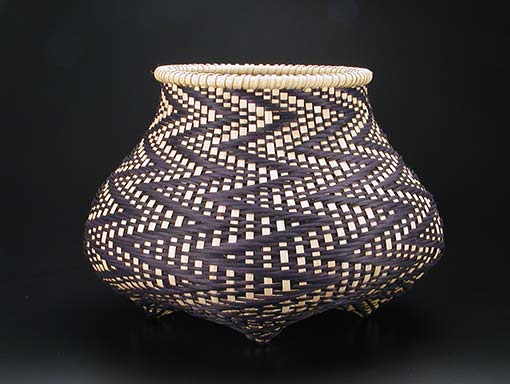Billie Ruth Sudduth Artist Statement
See also:
About Billie Ruth Sudduth Résumé

Fibonacci 8 by Billie Ruth Sudduth
My baskets blend the historical with the present through color, pattern, surface embellishment, and form. I am inspired by the classical shapes typical of Shaker and Appalachian baskets but I travel back over seven centuries for the most profound influence on my work: The Nature Sequence, developed by Leonardo of Pisa (Italy). Better known by his nickname, Fibonacci (ca 1170-1250), he was considered the most outstanding mathematician of the middle ages. The Nature Sequence, also known as Fibonacci Numbers, is written by starting with two 1s, adding them to get 2, then adding the next two numbers successively: the first few terms being 1,1,2,3,5,8,13,21,34,55,89, etc. After the first few Fibonacci numbers, the ratios of any two progressing numbers approximate the Golden Mean (1:1.618 or 5:8), which has been used to unify design since ancient Greece. Because Fibonacci numbers approach infinity, the design possibilities are unlimited. The ratios are found in the spacing of the spirals on seashells, on pineapples, in the arrangement of the florets in the center of a daisy or sunflower, and in the curve of an elephant’s tusk. Man has used the ratios in the shape of playing cards and window frames, on the piano keyboard and in the structure of great buildings. Farmers have used Fibonacci numbers to rotate their crops, stockbrokers have used them in investments, and computer engineers use them in computer programming. I use the Fibonacci numbers in my baskets. The rhythm of the pattern seems predetermined as if by nature itself.
Initially, I was concerned by my inability to free form, random weave, and become more expressive in expanding the possibility of a basket. However, the sense of order I gained by incorporating Fibonacci numbers in almost all of my work evolved into my “style,” a natural progression of balancing a family with a career. As I have become more secure in my work, I have felt more comfortable with the order in what I do and it has become the basis for the direction in which I want to continue. I want to expand the possibilities of design while maintaining function. This object called a basket should look like a basket and not be so far removed from form and function that it is not discernible as a basket.
Seneca said that art imitates nature. Whether viewed as art or craft, my baskets demonstrate this. The weaving utilizes a mathematical structure of spiral growth found in nature to create baskets with a rhythmic, naturally flowing design. They are both visual and tactile, beckoning the viewer to touch and explore with the eyes and hands. I do not separate myself from nature but through my weaving, affirm being a part of it.
